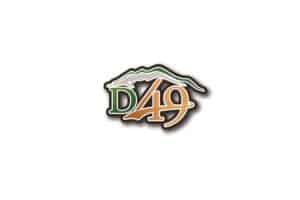Falcon School District 49 hosted a community budget meeting on Feb. 23 to explain how the school district receives its funding and how the funds are spent.Superintendent Dr. Ron Wynn opened the meeting repeating a question he hears many times: “What does the school district do with all the money it gets?” “Those who pay the bills have a right to know the full details about the education program,” Wynn said. “That’s what we want to do tonight. We want to give you the full details of where the money to educate students comes from and how it is utilized.”To analyze the cost impact, Gene Logas, assistant superintendent of business and auxiliary services, explained where the money comes from. He said 97 percent of the school budget comes from total program funding (TPF), which comes from three sources: local property tax, state equalization and specific ownership taxes. The state of Colorado determines the total dollar amount per student for each school district using a “state funding formula.” On Oct. 1 each year, the state counts every student in the district, which provides a base amount of money per student.Additional monies may be added to recognize district-to-district variances in cost of living, personnel costs, size of school districts, and the number of at-risk students in the district. D 49 has been on the losing end of this formula for several years. With the rapid growth and only one day counted per year, D 49’s student count changes drastically from the beginning of the school year to the end of the school year.”The state funding formula has robbed D49 of nearly $14 million in funding over the last six years,” Logan said. For the 2003-04 school year, D 49’s total program funding was $5611.81 per student.Local property taxes are also a source of inequity for the district. The average school district in Colorado receives 50 percent of its operating revenue from commercial and industrial property taxes. D 49 receives only 19 percent of its operating revenue from commercial and industrial tax dollars. This puts a much greater tax burden on homeowners in D49 and limits the district’s bonding capacity.However, according to the El Paso County assessor’s office, in 1993 a homeowner with an assessed home value of $101,207 paid $768 in school taxes. In 2004, a homeowner with an assessed home value of $222,729 paid $767 in school taxes.Falconites are paying less now than they did 11 years ago. Logas said the reason is the Gallagher Amendment, which lowers the ratio of market value to assessed value every two years, as more commercial development occurs statewide. For example, the ratio to market value in 1992 was 14.32 percent, and in 2004 it decreased to 7.96 percent. The commercial development in Falcon has not kept up with D 49’s needs.Will new commercial development increase the operating revenue of the school district?Not necessarily, Logas said. The state gives a dollar amount per pupil to the district. If property taxes grow, the equalization formula will account for it and lower the specific ownership taxes and state contributions. If the state determines that D 49 should receive $5611 per pupil, that is it. All affect the bonding capacity of the district. Without an increase in commercial development, the bonding capacity remains low and the only option to build new schools is a mil levy override, which was turned down by the voters last November.Now, where does the money go?Logas used a “typical” elementary classroom to describe where the funding is allocated. A classroom of 25 students funded at $5,611 per student equals $140,295 per classroom. The teachers’ salaries and benefits account for about 44 percent of the total program revenue, or $63,000 of the $140,295. Supplies, materials and printing used in the classroom (textbooks, periodicals, subscriptions, dues and fees) use up another $4,161 or 3 percent of the revenue. Equipment used in the classrooms, including computers, physical education equipment, musical instruction and art equipment, cost about $633 per classroom or .45 percent of the revenue.Contracted services use $466 or .33 percent of the revenue. Preschool, a program mandated by the state for certain at-risk students, costs $1,063 per classroom or .76 percent of the total revenue. The gifted and talented program for those students who excel in an academic area costs approximately $908 per classroom or .65 percent of the revenue.Special education, mandated by both state and federal law, accounts for $10,727 per classroom or 7.65 percent of the school’s revenue. Extra-curricular activities sponsored by the school, like sports, music, drama and student organizations take up $2,536 per classroom or 1.81 percent of the revenue. The subtotal of instructional costs is $83,419 per classroom or almost 60 percent of total program revenue.Can the remaining 40 percent be used to build schools?Logas emphasized that state and federal school regulations have increased. Student support services, such as nurses and health clerks, student records, guidance counselors and social work services take another 7.5 percent or $10,525. Costs designated to the budget of the principal, assistant principal and clerical staffs use another $8,768 or 6.25 percent.Building operations and maintenance also cost a substantial amount of money. “The schools are a community resource and are often opened from 6 a.m. to 10 p.m. for various functions,” Logas said. Utilities, grounds, equipment, vehicles, janitorial services and maintenance use another $14,853 per classroom or 10.57 percent. The subtotal for building support services equals $34,126 per classroom or 24.3 percent.Add this to the above total and approximately 84 percent of the total program revenue has been spent.Transportation services are a large expenditure for the district, but the state doesn’t mandate that school districts provide transportation. The exception is transportation for some special education students. These students must be transported from their home to school and back.D 49 does, like most districts, provide transportation buses for regular school days as well as after-school extra curricular activities. The cost of transportation services is $14,833 or 10.57 percent of the revenue. “The safety of students is paramount to the district, but this is one area we are looking at making cuts,” Logas said.Other costs include curriculum development; general administration which includes superintendent services, board of education services, legal and audit services, clerical support; financial services, which includes business services, budgeting, accounting, payroll, purchasing, and warehouse. In addition, there are added costs for human resources – staff hiring and training, in-service training, evaluations and risk management; information technology, programming services, telecommunications, systems upgrades and repairs and software licensing; and security and miscellaneous costs like workers compensation and unemployment.The grand total of the operating budget for 2003-04 was $141,009 or 100.5 percent of the total program funding. Lisa Schneider, financial manager for the district, also discussed the dire need for additional schools. “The Citizens Facility Study Committee recommended $76,738,038 for additional schools that should have been built last year,” Schneider said. “No school district in the state can find the money to build new schools in the total program funding – including D 49,” Logas said. “Meanwhile, in the next nine years, an additional 10,000 students will enroll in D49 schools.”The burning question: Should developers pay more?Several citizens asked why the developers are not contributing to the school district. Logas told the audience there is no law requiring any developer to support the school districts. They are required to contribute land for a school building, but that’s it.The City Council of Colorado Springs and the El Paso County Commissioners can make deals with developers to pay for new police stations, firehouses, roads, etc., but neither has a stake in the schools. The lack of support for schools from the city, county and state leaves the local taxpayer footing the bill through increased taxes.Note: District 49 will host another budget meeting in April at both Falcon High School and Sand Creek High School. Check the Web site or call the office for more information.





